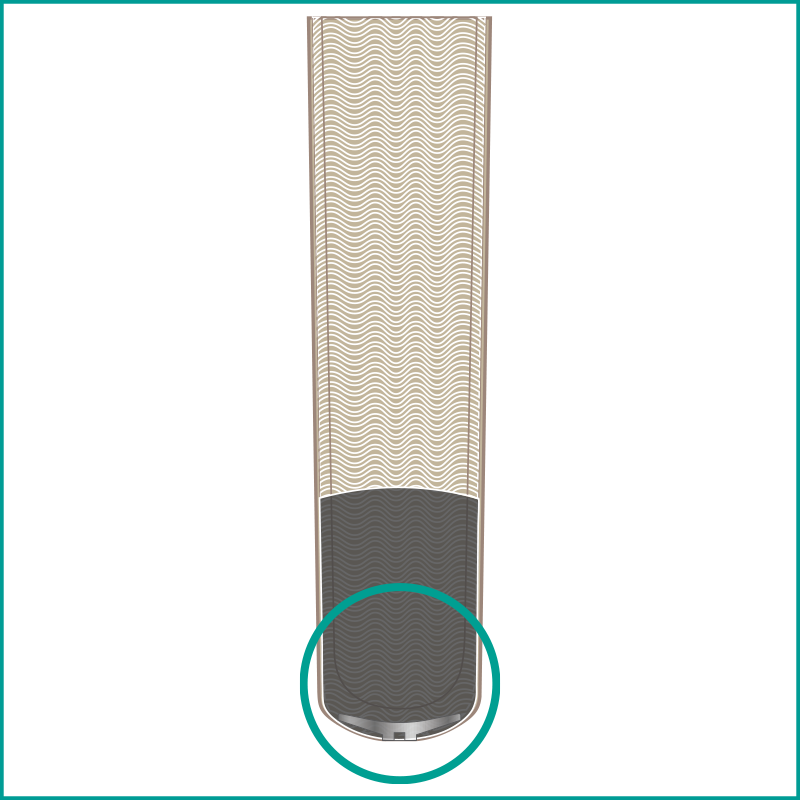
Distal End Construction
We are fully committed to providing reliable, high-quality prosthetic solutions for amputees, and our focus on distal-end construction is just another example of that commitment.
Our team of engineers works meticulously to ensure that every distal end is constructed to the highest standards, using only the best materials and components. The assembly process is unique and complex, involving several elements that fuse together to create a highly durable internal structure. This structure, bonded together with the gel and fabric, results in a liner that is guaranteed to provide the protection, comfort, durability, performance, and fit that our customers deserve.

Locking Liners: The Importance of the Distal End
Prosthetic liners play a vital role in a suspension system, as they provide protection and comfort while serving as an interface between the amputee's skin and the prosthetic. As such, we take the liner's materials used and construction process seriously. Not only must a liner be able to provide comfort and protection from the gel and fabric, but it also needs to be highly durable to withstand the continuous pressure and force that is applied to it while interconnected with the prosthesis. Therefore, the distal end becomes highly important for the liner's overall durability factor, as it must be secure and stable to function correctly to help maintain control over prosthetic movement.
The importance of how the distal end is constructed.
Common Construction: External
Many prosthetic locking liners available today feature a distal umbrella affixed to the fabric's exterior using adhesive. Consequently, these liners experience two primary issues. Firstly, there is no additional gel integrated at the distal end to offer extra cushioning. Secondly, the durability of the distal attachment relies solely on the bond (adhesive) between the distal umbrella and the fabric.
ALPS® Construction: Internal
To address issues with comfort and durability in external construction, we use an improved manufacturing method that fuses the three primary materials (gel, fabric, umbrella) on the inside of the liner, producing a superior, high-quality product.
The internal distal end construction implies that the umbrella is molded inside the fabric instead of being glued on from the outside.Within this internal structure, the umbrella is embedded with a thick layer of gel, which not only provides a means of bonding but also offers a cushion for user comfort. Additionally, some ALPS liners also have a grommet to enhance the reinforcement of the umbrella, gel, and fabric layers. Finally, the whole structure is encapsulated for protection. All of these materials together form a composite structure that provides a secure anchoring point for the umbrella. This ensures that the liner can be easily connected to a prosthetic device without the risk of breakage or separation.
6 styles for different needs.
As mentioned above, the gel, fabric, and umbrella are bonded inside the liner to form a reliable, durable distal end. However, each of these three components has a distinct role that serves the specific needs of the prosthetic wearer, taking into account the condition of their residual limb. To cater to these individual needs, we provide a range of liners, each with a unique combination of gel and fabric, and six different distal end styles that are designed to aid and cater to the specific purpose and recommended use of each liner.

EASYLINER
Features EasyGel, beige fabric, and a wide, flat encapsulation for easy donning and to accommodate larger residual limbs.

GP, AK, SP, EZF, VSDT
Features beige, brown, or black fabric and either GripGel or HD Gel. Has an encapsulation that is retrofittable across a wide variety of ALPS product lines.

ECO LINER
Features High-Density (HD) Gel, knitted fabric, and an encapsulation that is retrofittable across a wide variety of ALPS product lines.

SOFTSIL & ULTRASEAL
Features OptiSil, a low-profile umbrella, and all metal construction.

PRO-FIT LINER
Features OptiGel, a low-profile umbrella, and all metal construction.

SILICONE PRO LINER
Features silicone, knitted fabric, and a low-profile umbrella.
About the distal ends styles.
The reason why some liners have their own distal end while others share the same one depends on the liner's purpose for the prosthetic user. For instance, the EasyLiner has its own design to cater to amputees with specific clinical conditions such as low activity level, diabetes, and extremely sensitive skin. On the other hand, the General Purpose, Extreme, Superior Performance, EasyFlex, and Liberty Liners are more flexible and can be worn by a wide range of patients who do not have specific clinical conditions preventing them from wearing one liner over others with the same distal end. In such cases, patients can choose the liner based on their needs and preferences, such as the fabric type and gel they want. Therefore, an amputee with normal residual limb conditions could wear a Superior Performance Liner or a General Purpose Liner, depending on the best gel and fabric type for their specific needs.
Get an inside look at each distal end style below!

